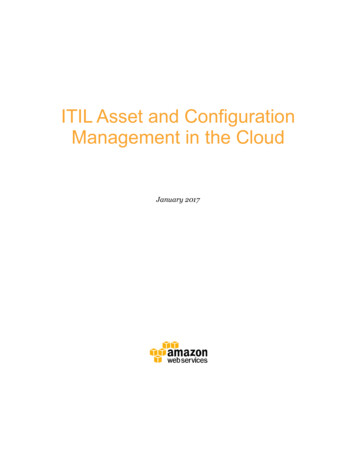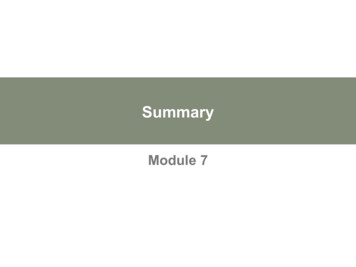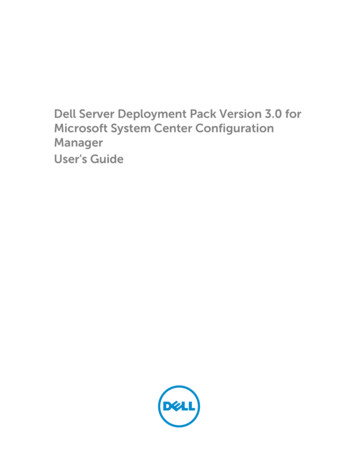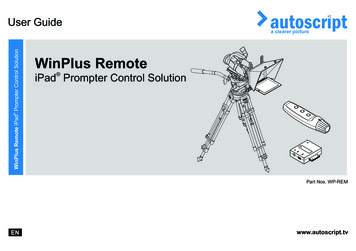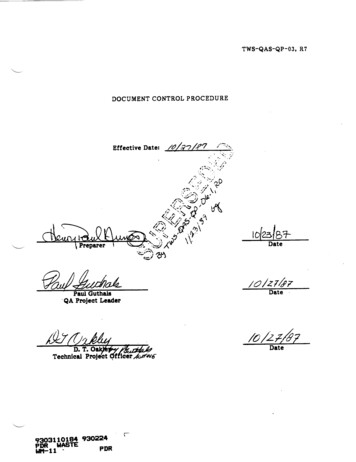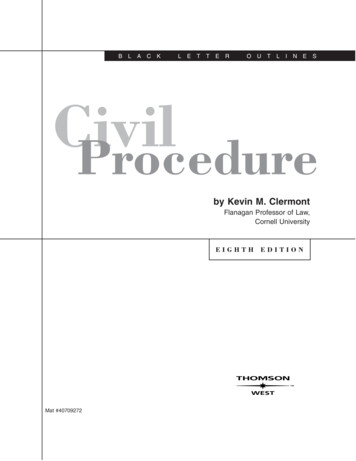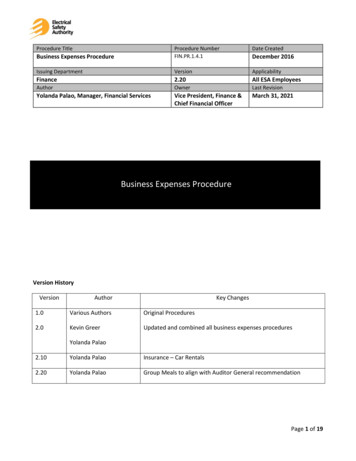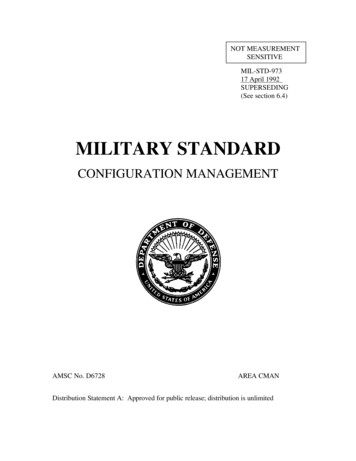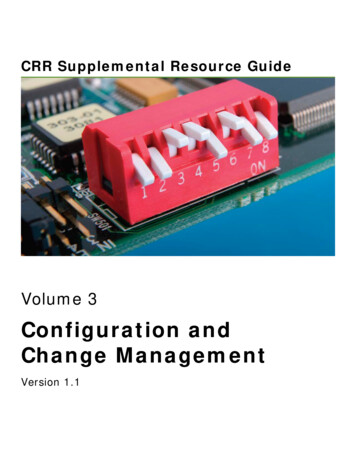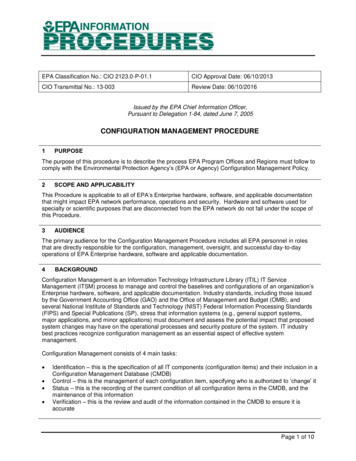
Transcription
EPA Classification No.: CIO 2123.0-P-01.1CIO Approval Date: 06/10/2013CIO Transmittal No.: 13-003Review Date: 06/10/2016Issued by the EPA Chief Information Officer,Pursuant to Delegation 1-84, dated June 7, 2005CONFIGURATION MANAGEMENT PROCEDURE1PURPOSEThe purpose of this procedure is to describe the process EPA Program Offices and Regions must follow tocomply with the Environmental Protection Agency’s (EPA or Agency) Configuration Management Policy.2SCOPE AND APPLICABILITYThis Procedure is applicable to all of EPA’s Enterprise hardware, software, and applicable documentationthat might impact EPA network performance, operations and security. Hardware and software used forspecialty or scientific purposes that are disconnected from the EPA network do not fall under the scope ofthis Procedure.3AUDIENCEThe primary audience for the Configuration Management Procedure includes all EPA personnel in rolesthat are directly responsible for the configuration, management, oversight, and successful day-to-dayoperations of EPA Enterprise hardware, software and applicable documentation.4BACKGROUNDConfiguration Management is an Information Technology Infrastructure Library (ITIL) IT ServiceManagement (ITSM) process to manage and control the baselines and configurations of an organization’sEnterprise hardware, software, and applicable documentation. Industry standards, including those issuedby the Government Accounting Office (GAO) and the Office of Management and Budget (OMB), andseveral National Institute of Standards and Technology (NIST) Federal Information Processing Standards(FIPS) and Special Publications (SP), stress that information systems (e.g., general support systems,major applications, and minor applications) must document and assess the potential impact that proposedsystem changes may have on the operational processes and security posture of the system. IT industrybest practices recognize configuration management as an essential aspect of effective systemmanagement.Configuration Management consists of 4 main tasks:Identification – this is the specification of all IT components (configuration items) and their inclusion in aConfiguration Management Database (CMDB)Control – this is the management of each configuration item, specifying who is authorized to ‘change’ itStatus – this is the recording of the current condition of all configuration items in the CMDB, and themaintenance of this informationVerification – this is the review and audit of the information contained in the CMDB to ensure it isaccuratePage 1 of 10
EPA Classification No.: CIO 2123.0-P-01.1CIO Approval Date: 06/10/2013CIO Transmittal No.: 13-003Review Date: 06/10/2016A configuration item is an IT asset or a combination of IT assets that may depend on and haverelationships with other IT processes. Configuration Management involves tracking all of the individualconfiguration items in an IT system in a CMDB. Information contained in the CMDB includes:HardwareSoftwareDocumentationPersonnelThe CMDB can be comprised of a multitude of different types of configuration items, each containingvarious attributes, and is used to document configuration item relationships and track their configuration. Aconfiguration item will have attributes which may be hierarchical and relationships that will be assigned bythe Configuration Manager in the CMDB. Appendix A lists some attributes that can be used to assist withidentifying the type and level of data a Program Office or Region may consider useful.5AUTHORITYEPA’s Configuration Management Policy, June 10, 20136RELATED DOCUMENTSCapability Maturity Model Integration for Development, Version 1.3, November 2010 CarnegieMellon, Software Engineering InstituteElectronic Industries Alliance 649, National Consensus Standard for Configuration Management,August 1998National Institute of Standards and Technology (NIST) Special Publication 800-12 (An Introductionto Computer Security; the NIST Handbook), October 1995Office of Management and Budget (OMB) Circular No. A-130, Management of Federal InformationSystems, November 2000Office of Management and Budget (OMB) Circular A-123, Management’s Responsibility for InternalControl, June 1995National Institute of Standards and Technology (NIST) Special Publication 800-53 (RecommendedSecurity Controls for Federal Information Systems), May 2010EPA System Life Cycle Management Policy, CIO 2121.1, September 21, 2012EPA System Life Cycle Management Procedure, CIO 2121-P-03 .0, September 21, 2012EPA Information Security Policy, CIO 2150.3, August 6, 2012Office of Management and Budget (OMB) Memorandum M-07-18, Ensuring New AcquisitionsInclude Common Security Configurations, June 1, 2007Office of Management and Budget (OMB) Memorandum M-08-22, Guidance on the FederalDesktop Core Configuration (FDCC), August 11, 20087CONFIGURATION MANAGEMENT PROCEDUREIn accordance with EPA’s Configuration Management Policy, Program Offices and Regions, inPage 2 of 10
EPA Classification No.: CIO 2123.0-P-01.1CIO Approval Date: 06/10/2013CIO Transmittal No.: 13-003Review Date: 06/10/2016collaboration with the Office of Environmental Information, Office of Technology Operations and Planning,must document, implement, and maintain configuration management processes.Configuration Management processes include properly identifying configuration items, controlling changes,and recording the change implementation status of the physical and functional characteristics of the ITinfrastructure. This ensures the overall integrity of the EPA Enterprise. This process is accomplishedthrough implementation of the five tenets of Configuration Management:Configuration Planning and ManagementConfiguration IdentificationConfiguration Change ManagementConfiguration Status AccountingConfiguration Verification and Audits7.1CONFIGURATION PLANNING AND MANAGEMENTProgram Offices and Regions must develop a strategy to define the scope and objectives of a configurationmanagement process as well as identify configuration items that shall be tracked within the CMDB. Theyshould also collectively decide, in collaboration with the Office of Environmental Information, Office ofTechnology Operations and Planning, which attributes of configuration items are necessary fordistinguishing between configuration items. When deciding what level of attribute to record it is importantto remember the frequency at which the data will be used, by whom it will be used, and what value can beplaced on it, together with the cost and effort involved in maintaining it.7.2CONFIGURATION IDENTIFICATIONProgram Offices and Regions must identify candidate system components, items, and data that will beplaced under configuration control and management. This encompasses the following:Identification of applicable configuration itemsEstablishment of baselines for control; maintenance of versions and revisionsIdentification of approved configuration documentation of the physical and functionalcharacteristics of the item or systemCreation of records in the CMDBProvision of documentation for configuration management and external auditsManagement of configuration item document library in CMBDConfiguration items should be managed throughout the system development life cycle in order to establishand maintain the integrity of the IT product or service. Appendix B lists what Program Offices and Regionscan classify as configuration items for information systems.7.3CONFIGURATION CHANGE MANAGEMENTProgram Offices and Regions must implement a controlled change process and provide tailored methodsPage 3 of 10
EPA Classification No.: CIO 2123.0-P-01.1CIO Approval Date: 06/10/2013CIO Transmittal No.: 13-003Review Date: 06/10/2016and standard operating procedures for effectively planning, recording, controlling, and validating productrequirements and data that contain the requirements. Tailoring will depend on the organization and thelevel of control or complexity needed.Configuration management control is accomplished by utilizing the CMDB, a centralized configurationmanagement database, or a series of databases that provide central, logical access to configuration data,containing relevant information such as the configuration items and their attributes, baselines,documentation, changes, and relationships. Requests for Changes must be stored in the CMDB.7.4CONFIGURATION STATUS ACCOUNTINGThe CMDB tool must be used to track submitted Requests for Changes. The objectives of the system areto provide enhanced coordination, visibility, and accountability. Records describing configuration itemsmust be established and maintained in the CMDB. The tool must assign a unique identifier to eachRequest for Change and maintain a repository of all change requests.Program Offices and Regions must record actions in sufficient detail that the content and status of eachConfiguration Item is known and previous versions can be recovered. Organizations must maintainproduct description records, configuration verification records, change status records, and history ofchange approvals.The CMDB must contain relevant information about configuration items, their attributes, baselines,documentation, changes, and relationships. The recording of changes must include:The reason for the changesIf a proposed change to the configuration item is accepted, a schedule for incorporating the changeinto the configuration item and other affected areasIndication that changed configuration items have been released only after review and approval ofconfiguration changes. Changes are not official until they are approved7.5CONFIGURATION VERIFICATION AND AUDITSConfiguration auditing must be performed by Program Offices and Regions to verify the integrity of theprocesses, systems, items, and baselines under Configuration Management control. The ConfigurationManager conducts these audits to ensure baseline compliance of the configured assets’ hardware,software, and controlled documentation with established requirements, specifications, and functionalparameters. Change control processes are also subject to Configuration Management Audits.Additionally, Configuration Management Audits must be used to ensure the accuracy of the CMDB;address the effectiveness of the Change Advisory Board; determine the accuracy and completeness ofConfiguration Management processes; verify data and documentation; and ensure project compliance withrequirements, standards, and conventions.All audit records and respective deficiencies must be placed into the CMDB, which shall be used to trackcorresponding action items, suspense dates, and close-out activities. The Configuration Manager candecide whether these attributes need to be tracked within the CMDB since he/she is responsible forPage 4 of 10
EPA Classification No.: CIO 2123.0-P-01.1CIO Approval Date: 06/10/2013CIO Transmittal No.: 13-003Review Date: 06/10/2016conducting periodic audits. The CMDB must be used to maintain a historical file of all audit informationthroughout the applicable life cycle.The Configuration Manager must conduct its audits on a periodic basis following a defined audit sequence.The Configuration Manager must have the responsibility to initiate the audit sequence and oversee itsimplementation.8ROLES AND RESPONSIBILITIESRequired roles and responsibilities may be fulfilled by one or more individuals.Change Advisory Board (CAB) is responsible for:Provide enterprise risk management, communication management and process compliancemanagement to the change process environment;Review/Approve changes and ensure changes to EPA infrastructure or contracted EPA systemsare reviewed and processed in accordance with established Change Management processes andprocedures;Establishing a secure and sound configuration management framework ensuring definition andmaintenance of configuration baselines and the identification, management and tracking ofassociated hardware, software and documentation configuration items for each EPA system;Ensuring all changes to configuration items adhere to EPA policy and are documented, tested, andapproved. This includes ensuring changes are evaluated to determine the impact to systemsecurity before implementation;Ensuring that EPA Configuration and Change Management process documents are maintained asa Configuration Item (CI) component and placed under configuration management control; andReporting on the effectiveness of the Configuration and Change Management activities toexecutive leadership.Change Coordinator is responsible for:Coordinating and facilitating CAB meetings;Documenting and distributing CAB meeting minutes, decisions and actions;Reviewing proposed Requests for Changes;Preparing and distributing implementation schedules for all approved changes;Providing immediate disposition of directed or emergency changes, without going through themechanism of change control;Assisting with Change Post Implementation Reviews;Collecting, collating and reporting change management metrics; andExecuting tasks delegated by the CAB Chairperson.Page 5 of 10
EPA Classification No.: CIO 2123.0-P-01.1CIO Approval Date: 06/10/2013CIO Transmittal No.: 13-003Review Date: 06/10/2016CAB Chairperson is responsible for:Managing and maintaining the Change Control process;Ensuring compliance to the Change Control process;Tabling Requests for Changes for CAB meetings;Determining CAB meeting participants based on the nature of the Requests for ChangesChairing the CAB;Convening meetings to consider emergency Requests for Changes;andActing as a central point of contact and escalation point for change management issues.Configuration Manager is responsible for:Overall responsibility and authority for the Configuration Management process;Handling all Configuration Management issues involving management and oversight ofrequirements; architectural integrity; site configurations; version control; hardware/softwaredevelopment; interoperability; status accounting; change disposition; auditing; and, adherence toestablished standards and guidance;Ensuring that proposed changes are executed within a disciplined process, giving adequateconsideration to the technical, programmatic, security, and schedule impacts of the proposedchanges;Conducting audit reviews;Initiating the audit sequence and overseeing its implementation; andAssigning attributes to configuration items.Change Implementers are responsible for:Testing requested changes;Implementing changes;Reversing changes;Entering configuration status accounting information; andResponding to inquires regarding changes.Change Requestor is responsible for originating a Request for ChangeChief Technology Officer (CTO) is responsible for:Providing procedures, standards, and guidance to senior level managers in support of theAgency’s Configuration Management Policy;Page 6 of 10
EPA Classification No.: CIO 2123.0-P-01.1CIO Approval Date: 06/10/2013CIO Transmittal No.: 13-003Review Date: 06/10/2016Instituting change management processes; andProviding a change approval system for EPA (i.e., CDMB, a change approval and trackingapplication and database).Office of Environmental Information, Office of Technology Operations and Planning (OEI-OTOP) isresponsible for addressing questions and concerns regarding interpretation of these procedures.Program Offices and Regions are responsible for maintaining explicit control of changes to the businesssystems under their authority.Senior Information Officials (SIOs) are responsible for ensuring that their office is in compliance withEPA Configuration Management Policy and Procedures.9DEFINITIONSChange Advisory Board is a group of people responsible for evaluating and approving or disapprovingproposed changes to configuration items, and for ensuring implementation of approved changes.Change Management is a critical discipline that controls and communicates the changes occurring in theIT environment.Configuration Audit is an audit conducted to verify that a configuration item, or a collection ofconfiguration items that make up a baseline, conforms to a specified standard or requirement.Configuration Baseline is configuration information formally designated at a specific time during aproduct’s or product component’s life. Configuration baselines, plus approved changes from thosebaselines, constitute the current configuration information.Configuration Control is an element of configuration management consisting of: the evaluation,coordination, approval or disapproval, and implementation of changes to configuration items after formalestablishment of their configuration identification.Configuration Identification is an element of configuration management consisting of: selecting theconfiguration items for a product, assigning unique identifiers to them, and recording their functional andphysical characteristics in technical documentation.Configuration Item is an aggregation of work products that is designated for configuration managementand treated as a single entity in the configuration management process. This aggregation consists of allrequired components: hardware, software, and other items that comprise a baseline.Configuration Item Attributes are descriptive characteristics of configuration items (CI), such as a makeor model number, version number, supplier, purchase contract number, release number, data format, roleor relationship, held in the Configuration Management database (CMDB).Configuration Management is fundamentally the science of tracking the exact state of the overall ITenvironment at any point in time. It is a discipline applying technical and administrative direction andsurveillance to (1) identify and document the functional and physical characteristics of a configuration item,Page 7 of 10
EPA Classification No.: CIO 2123.0-P-01.1CIO Approval Date: 06/10/2013CIO Transmittal No.: 13-003Review Date: 06/10/2016(2) control changes to those characteristics, (3) record and report change processing and implementationstatus, and (4) verify compliance with specified requirements.Configuration Management Database is a Database which stores attributes of CIs and relationships withother CIs.Configuration Status Accounting is an element of configuration management consisting of the recordingand reporting of information needed to manage a configuration effectively. This information includes alisting of the approved configuration identification, the status of proposed changes to the configuration, andthe implementation status of approved changes.10WAIVERSNo waivers will be accepted from the requirements of this procedure.11RELATED PROCEDURES AND GUIDELINESEPA NCC Change Management Process, DOCUMENT NUMBER: PS-01-8001 CM, Version: 1.0,August 7, 2009EPA NCC, Change Management Procedure, DOCUMENT NUMBER: PE-01-8001 CM, Version:1.0, August 7, 200912MATERIAL SUPERSEDEDConfiguration Management Procedure, CIO Transmittal No.: 12-001, EPA Classification No.: CIO 2123.0P-01.0, CIO Approval Date: 03/27/201213ADDITIONAL INFORMATIONFor more information on this procedure, please contact the Office of Environmental Information, Office ofTechnology Operations and Planning, Mission Investment Solutions Division.Malcolm D. JacksonAssistant Administratorand Chief Information OfficerOffice of Environmental InformationPage 8 of 10
APPENDIX AConfiguration Item AttributesLocationModel / Hardware SoftwareConfigurationSource codeSoftware LicensesDocumentationStatusMaintenance ContractIncident RecordsProblem RecordsChange RecordsUser associated with the configurationitemRelationships with other configurationitemsPhysical location of the Configuration Item(Region/Program, Building, Floor, Section,Room, etc.)Details of specific Model purchased,software version, hardware manufacturerspecifications, specific HW and SWConfiguration Image applied, etc.Name, Owner, Version, Date, Location,etc.Software agreement(s) detailsName, Author, Version, Date, Location,etc.Ordered, Delivered, Installed, Repair,Stolen, Decommissioned, Disposed, etc.Bronze, Silver, Gold, PlatinumOpen and Closed, Historical and PresentOpen and Closed, Historical and PresentPlanned and Completed, Future andHistoricalName, Job Function/Title, Telephone,Contact details, etc.Both Parent & ChildPage 9 of 10
APPENDIX BConfiguration Item IdentificationGoalTo improve impactassessments of ITinfrastructure changes to ITservicesTo track, analyze andreport on changes made tothe agency’s ITinfrastructureInclude Configuration Itemsthat:Demonstrate relationshipsacross IT components (e.g.hosting, networking,databases, etc.) thatcomprise the IT service.May or will have a HQ orAgency-wide impact. Thesetypes of changes includedesktop solutions, mobiledevices, hardware,software, networkenvironments, middleware,firmware and systemsmanaged by OEIs’ Office ofTechnology Operations andPlanning or changes madeat the Regional level thatmay have an impactbeyond the region.Which will make it possibleto:Determine how a change toone device (e.g. server)might affect other systemsin an IT service.Track Configuration Itemsthat changed, number ofchanges made, and whenthe changes were made.Page 10 of 10
Configuration Management consists of 4 main tasks: Identification – this is the specification of all IT components (configuration items) and their inclusion in a Configuration Management Database (CMDB) Control – this is the management of each configuration item, spe
